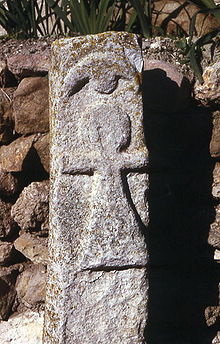San el Hagar
Tanit
 Tanit was a Carthaginian and Phoenician goddess. Immanuel Velikovsky claimed that the name of modern Tunis, near the site of Carthage, is a cognate of Tanit. She was also adopted by the Berbers and claims have been made that Tanit was also a Hyksos goddess.
Tanit was a Carthaginian and Phoenician goddess. Immanuel Velikovsky claimed that the name of modern Tunis, near the site of Carthage, is a cognate of Tanit. She was also adopted by the Berbers and claims have been made that Tanit was also a Hyksos goddess.
The Egyptian city of Sais where Solon first learned of Atlantis had it principal temple dedicated to the goddess Neith, whom the Egyptian priests identified with Athene. In turn, Neith is also associated with the Libyan goddess Tanit.
The whole matter of the relevance of Saïs to the Atlantis story has been challenged by the theory(a) that Saïs and Tanis, named after Tanit, were in fact the same location. A starting point is the fact that the current village of Sa el Hagar adjacent to the ruins of Saïs has a counterpart at Tanis where there is a village called San el Hagar. Drawing on the writings of Strabo, Herodotus and the Bible some have concluded that the two cities were one. Velikovsky also proposed this idea in his Ramses II and His Time[0832.209], noting that “Tanis is mentioned in Scriptures as the capital of Egypt when. according to both the conventional plan and this reconstruction, Saïs was the capital.”
The island of Es Vedra off the west coast of Ibiza, the third largest of the Balearics, has had a number of imaginative myths, old and new, associated with it, including one that it is supposed to be the birthplace of Tanit!
(a) https://h2g2.com/forums/A148907/conversation/view/F19585/T7572591/page/1/
Saïs
Saïs was a city on the Nile delta that, according to archaeology, existed at least from 3000 BC. Diodorus Siculus claimed that Saïs had been built by the Athenians before the flood of Deucalion (Histories 5.57). The present settlement is called Sa el Hagar.>According to Frank Joseph(e), Leo Frobenius made this identification a century ago. However, L. Taylor Hansen mistakenly identified Saïs with Port Said! [572.24]<
The Septuagint version of the Bible identifies Saïs with Pelusium, mentioned in Ezekiel 30:12-15. During the 7th century BC it became the capital of the pharaohs of the 26th Dynasty.>Egerton Sykes suggested different dates(f).<
>R. Reese wrote “The ancient city dates back to 3,000 B.C, however, habitation at the site extends back to the pre-dynastic and Neolithic period, from at least 4,200 B.C. It was the provincial capital of the fifth nome of Lower Egypt, known as Sap-Meh. During the twenty-fourth dynasty of Egypt, spanning from 732–720 BC, Sais was the seat of power. At that time, it was known as Zau(d).”<
Saïs is the Egyptian city where Solon originally learned of the story of Atlantis. It housed the principal shrine of the Egyptian goddess Neith who has been identified with Athene. The Greek writer Charax of Pergamon (c. 200 AD) reflected this connection when he wrote that the citizens of Saïs referred to themselves as Athenai and Diodorus Siculus states that the Athenians claim to have originally come from Saïs. There is an ancient if disputed, tale that Cecrops, the first king of Athens established the city with colonists from Saïs.
This of course conflicts with Plato, who, in Timaeus (23e) informs us that the city of Saïs (not Egypt, as some assume) was founded one thousand years after the city of Athens or 8,000 years before Solon’s visit. This, however, creates a problem, as it suggests that Athens was founded at the same time that it fought and defeated a powerful long-established invader!
No remains of the temples, with their celebrated inscribed pillars, have as yet been discovered. However, excavations are proceeding under the sponsorship of the Egypt Exploration Society and the University of Durham led by Dr Penelope Wilson(b).
>A 2021 article(c) reviewing the history of Saïs noted that “The city enjoyed a high period under the 26th Dynasty Kings (664-525), who made Sais their Capital until the Persian invasion of Cambyses. It continued to exist down into the Ptolemaic and Roman periods BC. In the last two thousand years, however, Sais declined and was largely forgotten, its temples and walls demolished, its remains pilfered. Today nothing much remains except a tiny village called Sa el-Hagar, some garbage heaps and a few scattered ruins.”<
The whole matter of the relevance of Saïs to the Atlantis story has been challenged by a theory on the Internet(a) that Saïs and Tanis were in fact the same location. A starting point is the fact that the current village of Sa el Hagar adjacent to the ruins of Saïs has a counterpart at Tanis where there is a village called San el Hagar. Drawing on the writings of Strabo, Herodotus and the Bible some have concluded that the two cities were one. Immanuel Velikovsky proposed this idea in his Ramses II and His Time [832.209].
(a) https://h2g2.com/forums/A148907/conversation/view/F19585/T7572591/page/1/
(b) https://www.dur.ac.uk/penelope.wilson/sais.html
(c) https://www.ancientscribbles.com/2021/01/ruins-of-sais-and-temple-where-to-be-found.html (link broken) *
(e) Atlantis Rising Magazine #20 *
(f) Sykes’ Atlantis AT142 p.47 *
